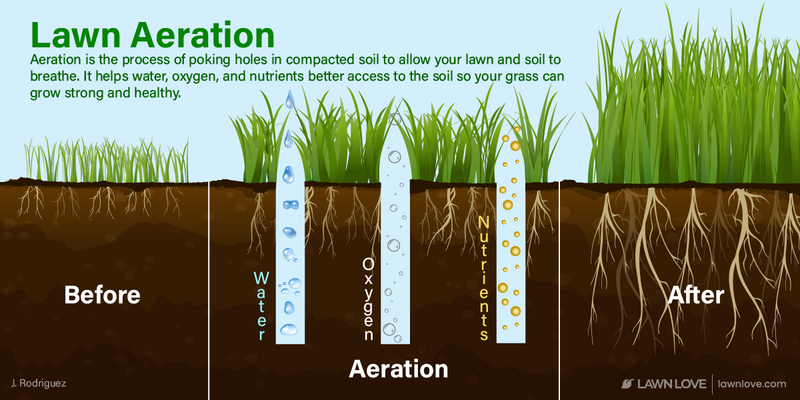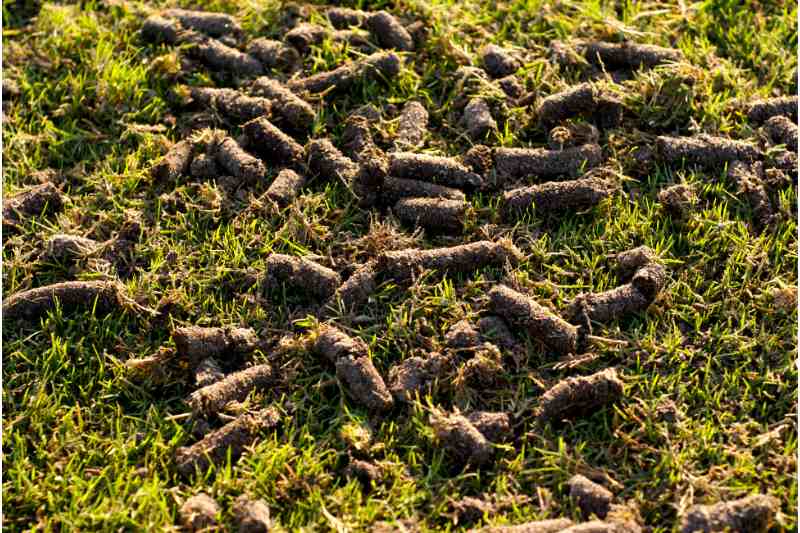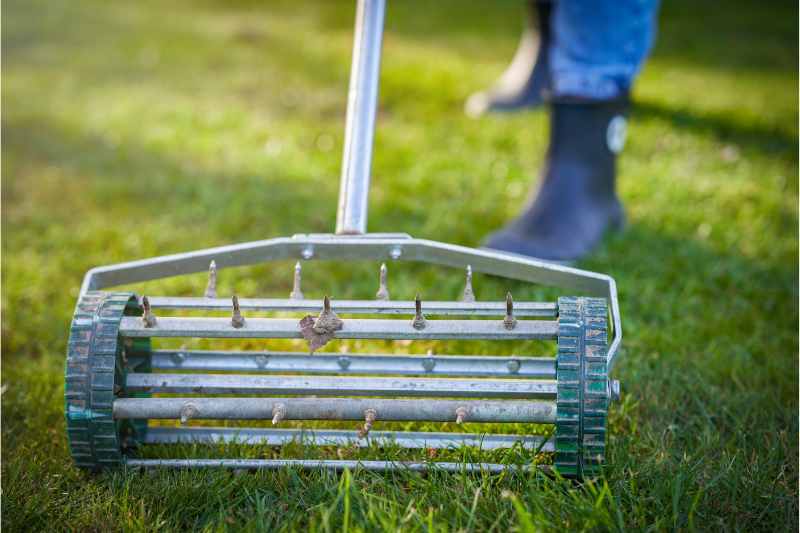
If your grass isn’t looking its best, it may need a breath of fresh air. Aerating your lawn is a natural way to solve soil compaction problems, improve drainage, and get your grass thick and healthy for peak growing.
Aeration is like an exfoliating facial for your lawn, loosening surface soil to give tender grass roots the nutrients they need. Core aeration and spike aeration are two major methods to give your lawn a spa day. We’ll walk you through the pros and cons of core aeration versus spike aeration to help you determine which method your yard needs.
What is aeration?

Aeration, also known as aerification, is the process of perforating (poking small holes in) your lawn to alleviate soil compaction, prevent excessive thatch buildup, and increase the flow of oxygen, water, and nutrients to the root zone.
Kids at play, construction projects, and severe weather can compact your soil, leaving roots without a place to grow. Aeration is an easy way to loosen the soil and give your grass space to spread out again.
Core aeration and spike aeration are the two major methods of lawn aeration for homeowners and lawn care professionals. Your lawn type, level of soil compaction, and budget will determine which aeration option is best for you.
When lawn experts talk about aeration, they’re usually referring to core aeration (also known as plug aeration). Core aeration is the preferred method for long-lasting lawn health.
However, spike aeration may be the way to go if your lawn is mildly compacted and you’d like an inexpensive DIY fix to spur grass growth.
What is core aeration, and how does it work?

ArtBoyMB | Canva Pro | License
A core aerator is basically a big hole punch for your yard. When you aerate, though, you aren’t preparing homework assignments. You’re giving roots space to breathe and access to essential water, oxygen, and nutrients.
Core aeration pokes hollow tines into the ground and extracts small plugs of soil that fall onto the lawn. These plugs act as a natural top dressing and help decompose thatch. Core aeration is the method of choice for lawn pros because it effectively loosens the soil, giving root systems access to nutrients and keeping soil more nutrient-rich in the long term.
Core aeration will leave your yard freckled with little holes, but they’ll fill in with denser, healthier grass. According to the Virginia Tech Extension, “Core aeration is very disruptive to surface smoothness, but it is the best way to relieve the physical limitations of soil compaction and improve soil oxygen levels.”
3 types of core aerators
1. Manual core aerators
If you have a small yard and a free afternoon, a manual core aerator is an inexpensive option. It’s also a great choice for spot aeration if you have a few compacted problem areas.
- You’ll push the manual core aerator into the ground, using your foot as an additional weight, and cores will come out of the top of the tines.
Manual core aerators are best for: Small lawns with mild to moderate soil compaction, or highly compacted areas in need of spot aeration
Price: $25 to $90, depending on the quality and number of tines
Rental cost: Most manual aerators are only available to buy. You may be able to rent one if your city has a tool library.
2. Gas-powered core aerators
Most homeowners opt for a gas-powered, push-behind core aerator, which looks similar to a lawn mower. You’ll want to go over your lawn at least twice with the aerator, “mowing” once in one direction, then the second time perpendicularly.
- For every square foot, create about 20-40 holes (2 to 3 inches apart).
- When you’re done, your lawn will look like a checkerboard.
Gas-powered, push-behind core aerators are best for: Medium to large lawns with moderate to high soil compaction
Price: $1,430 to $6,640
Rental cost: Approximately $70 for four hours or $105 for a full day
3. Tow-behind core aerators
If you have a lawn tractor and want an easy solution to core aeration, you can invest in a tow-behind (also known as pull-behind) plug aerator. They’re pricey, but they’ll save you time and energy.
- Choose one with a weight tray to ensure the tines fully perforate the ground.
Tow-behind plug aerators are best for: Larger lawns with a moderate to severe compaction problem.
Price: Prices range from $50 to $380 (though you could pay thousands for an industrial-grade model). For a high-quality tow-behind option, expect to pay more than $200.
Rental cost: Approximately $35 for four hours or $55 for a full day
What type of lawn should be core aerated?
Core aeration is ideal for lawns that:
- Are heavily compacted
- Experience heavy foot traffic
- Haven’t been aerated in years
- Recently underwent construction
- Have heavy clay soil
- Are medium or large
- Have a severe thatch problem
Pros and cons of core aeration
Pros of core aeration:
✓ Long-term fix: Hollow tines loosen and remove soil so air holes open up, roots can grow deeper, and grass grows more densely
✓ Eco-friendly: Reduced compaction leads to less runoff and pollution and decreases the need for water and fertilizer
✓ Increases the visual appeal of your lawn in the long term
✓ Cores act as compost, so you can simultaneously aerate and top dress your lawn
✓ Decreases the need to dethatch your lawn
✓ Dense grass growth prevents weeds from invading your lawn
✓ Good for medium to large lawns with heavy compaction and heavy foot traffic
Cons of core aeration:
✗ Can stress your lawn if you aerate in the wrong season or too often
✗ Before holes fill in, they can be visually unattractive
✗ Plugs left on your lawn can look messy and unappealing (before they decompose)
✗ Weeds can sprout in holes if pre-emergent herbicide is not applied
What is spike aeration, and how does it work?

Spike aeration is basically core aeration minus the hollow tines. If core aeration is like using a hole puncher on paper, then spike aeration is like poking through the paper with the tips of scissors.
When you spike aerate, no soil is removed. Instead, soil is squeezed to all sides of the solid tine. The spike marks in your lawn will not be as deep than the perforations created by core aeration.
Spike aeration loosens soil and alleviates compaction in the short term, but it increases compaction in the long run.
4 types of spike aerators
1. Pitchforks
Pitchforks aren’t an efficient option for a larger lawn, but they’re excellent for smaller areas (less than 1,000 square feet) or for spots that get heavy foot traffic and need extra care.
- It’s easy to aerate with a pitchfork: Insert tines into the ground 3-4 inches deep and tilt forward and backward to loosen the soil.
Pitchforks are best for: Tiny, postage-stamp-sized lawns with mild soil compaction or specific areas that need special attention.
Price: $30 to $130 (but you probably already have one in your garage).
Rental cost: Pitchforks are only available for purchase. You may be able to rent one if your city has a tool library.
2. Spiked aeration shoes
Spiked lawn aeration shoes are the least expensive spike aeration option. You can use them in small areas, but for larger areas, aerating with spiked shoes is a time-consuming, tiring task. Using spiked shoes is not a highly effective form of aerating, and many lawn pros warn against it.
- Walk over each area of your lawn thoroughly, piercing the soil with each step.
Spiked aerator shoes are best for: Very small areas with mild compaction.
Price: $10 to $50
Rental cost: Spiked shoes are only available for purchase. You may be able to rent one if your city has a tool library.
3. Rolling push aerators
Rolling push aerators look like large spiny paint rollers. They work well for small, mildly compacted areas. If your lawn is on the moderate or larger side or if your soil is rocky or highly compacted, a rolling spike aerator is not the best option. It takes a lot of muscle to use, and the aerator may get damaged.
- A rolling push spike aerator works like a manual mower. You’ll want to go over your lawn at least twice, once in one direction, and the next time perpendicular to that direction.
- To maximize the tine penetration, choose a model with a steel tray for additional weight.
Rolling push aerators are best for: Smaller lawns with mild soil compaction
Price: $50 to $135
Rental cost: Approximately $25 per day
4. Tow-behind spike aerators
Tow-behind spike aerators are on the expensive side, but they save time and labor and are excellent for larger lawns and fields. Make sure to purchase one with a weight tray to maximize contact with the soil.
- Tow-behind spike aerators are similar to tow-behind core aerators, but instead of corers, they feature 10-12 star-shaped blades that pierce the soil.
Tow-behind spike aerators are best for: Larger lawns with mild to moderate compaction
Price of a tow-behind spike aerator: $85-$1,150. Prices vary, but expect to pay $135 or more for a high-quality model
Rental cost: Most tow-behind spike aerators are only available to buy
What type of lawn should be spike aerated?

Spike aeration works well for lawns that:
- Have mild to moderate compaction
- Are small to medium in size
- Don’t have many rocks, stones, or debris in the soil that could interfere with spikes
- Have a mild thatch problem (a thatch layer of just over half an inch)
- Don’t have a high clay content
Pros and cons of spike aeration
Pros of spike aeration:
✓ Quick fix: Solid spikes shift the soil and provide temporary air holes, but soil compacts at spike entry points
✓ Generally less expensive than core aeration
✓ Less disruptive to the soil surface than core aeration
✓ Creates less mess: Does not leave plugs of soil scattered around the lawn
✓ Can be used frequently in compaction-prone areas without disrupting the lawn’s visual appeal
✓ Good for small lawns with mild compaction and lower foot traffic
Cons of spike aeration:
✗ Spikes increase compaction in the long term
✗ Time-consuming and labor-intensive: Shoes and rolling spike tools are not ideal for larger areas
✗ Less effective than core aeration
✗ Does not penetrate as deeply into the ground as core aeration
✗ Compaction leads to more lawn problems in the future: Grass will be weaker and more prone to diseases
✗ Compaction harms surrounding ecosystems through increased fertilizer use, erosion, and runoff
To learn more about the benefits of aeration, from increasing your grass’s drought tolerance to protecting your lawn from diseases, check out Lawn Love’s “Benefits of Aerating Your Lawn.”
Does my lawn need to be aerated?
As a general rule, lawns need annual aeration to prevent compaction and keep grass growing densely.
- Lawns with high clay content or foot traffic may require aeration twice per year.
- If your soil is sandy or if you have no drainage issues, you may only need to aerate every two to three years or simply spot aerate as needed.
Spikes do not aerate as deeply or as thoroughly as cores, so if you choose spike aeration, you’ll need to aerate more frequently. Spike aerate two to three times per year during the growing season, targeting places prone to compaction.
Lawns with sandy soils could thrive for as long as five years after a single aeration, whereas with clay soils, your grass might start losing its color just eight months after being aerated. To make sure you’re aerating on the healthiest basis for lawns in your region, contact your local extension service.
How to test your lawn for compaction
What’s a quick test to check if your grass needs to be aerated? Cut out a square foot section of lawn at least 6 inches deep. If the grass roots are growing only 1 to 2 inches deep, your soil may be compacted and need aeration.
Alternatively, give your lawn the old “screwdriver test.” If you can easily push a screwdriver 3 inches into moist soil (without undue force like jabbing), then lawn aeration is likely not necessary.
Signs your lawn needs aeration
If compacted soil is causing a problem, your grass won’t be shy to let you know. These lawn symptoms are good indicators that your lawn needs aerating:
- Your lawn feels spongy and dries out easily.
- Your soil is hard to the touch.
- Your lawn isn’t draining properly during rainstorms, and puddles are forming where they did not before.
- Your grass is thinning and becoming discolored.
- Your grass is developing diseases like brown patch.
- Your lawn gets heavy foot traffic.
- Your house was newly built or you have recently had construction done.
- Your lawn was laid from sod. If sod is not mixed with the soil underneath, the grass roots may struggle to grow into the lower layer of soil. Aeration breaks up the soil layering to spur root growth.
Even if your lawn isn’t in desperate need, aeration is a natural way to stimulate beneficial microbial growth, promote thatch decomposition, and increase oxygen flow to roots, which will get your grass growing faster and looking healthier.
When should you aerate?
Aerate during your grass’s active growing season so that grass recovers quickly and fills the holes in your lawn. To know when the growing season is, you need to know what grass type you have.
- For cool-season grass lawns with types like tall fescue and Kentucky bluegrass, fall is the ideal time to aerate. While cool-season lawns can be aerated in either early spring or early fall, fall is preferred because weeds are less likely to sprout in the holes.
- For warm-season lawns with grasses like Bermudagrass and Zoysia, aerate in late spring or early summer when the grass is growing most vigorously. This will ensure speedy lawn recovery.
Aerate in the right season for your region to prevent lawn stress. Avoid aerating during the peak heat of summer or in the cold of winter when grass is dormant. Aerate the day after rain or irrigation so your lawn is slightly moist but not wet. The soil shouldn’t be so muddy that it sticks to the tines.
FAQ about core vs. spike aeration
What lawn improvements can I expect from aeration?
Aeration will decrease your lawn’s susceptibility to pests and diseases, eliminate yellow and brown spots, and increase the number of beneficial organisms in your yard (like earthworms, which keep your soil loose and nutrient-rich for lasting grass health).
Aeration stimulates renewed growth, so you can expect your grass to grow greener and more rapidly than before, with deeper roots and stronger shoots. Your lawn will be lush, and holes will be healed in three to four weeks after aerating.
How long does it take to aerate my lawn?
With a tow-behind or walk-behind aerator, you can aerate a medium-sized, 10,000-square-foot lawn in an hour to an hour and a half. If you want to call in the pros, they can do the job in as little as 30 minutes.
The less sunny news? If you’re using a manual core aerator or spiked shoes, it’ll likely take a full morning or longer, and you may have to take breaks depending on your lawn size.
Will aerating my lawn damage my irrigation system?
Not if you take precautions. Make sure you mark your sprinkler heads clearly with flags, stakes, or spray paint before you aerate. That way, you won’t have an aeration tine ramming right into your watering system.
What should I do after aerating my lawn?
Water your lawn thoroughly after aerating. This is also a great time to overseed, apply compost and fertilizer, and amend your soil (i.e. if your soil is too acidic, now is the time to apply lime).
Want to make sure your grass grows evenly? Wait a month after lawn aeration before overseeding so that holes are healed before you plant.
If you’re not planning to overseed after aerating, you can apply a pre-emergent herbicide to prevent weeds from popping up in empty holes.
Can I combine core aeration with spike aeration to give my lawn some extra care?
You can, but use caution to ensure you’re not aerating too much.
Core aerate yearly to give your lawn thorough aeration. Then, if your lawn needs an extra boost during the growing season, you can spike aerate. The thin tines from spike aeration won’t disrupt the visual appeal of your lawn like the larger holes and plugs from core aeration.
If reducing compaction is your long-term goal, you’ll want to stick to core aeration.
Choosing spikes or cores
If you’re ready to give your grass a refreshing breath of air and a natural dose of nutrients, aeration is the way to go. Spike aeration is a quick fix for a mildly compacted lawn. But for a long-term lawn health solution, core aeration will give your grass what it needs for sustained, dense growth.
Want your grass to grow greener but don’t have the time to aerate? Call a local lawn care professional to aerate away the day, so you can breathe easier without sweating it out in your yard.
Main Photo Credit: Shutterstock